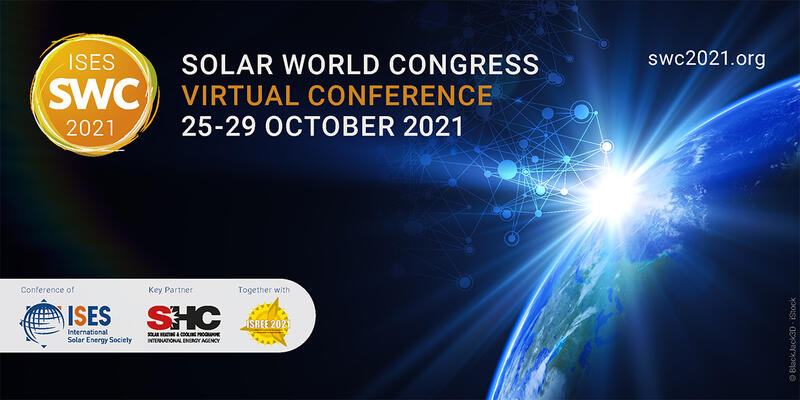Reflections on SWC 2021
by Dave Renné, Congress Chair
The International Solar Energy Society’s Solar World Congress 2021, which took place as an online event during the week of 25-29 October, was held against the backdrop of the impending 26th United Nations Climate Conference of the Parties (COP-26). The COP-26 climate negotiations started just two days after the SWC 2021 Closing Ceremony.
This timing of the SWC 2021 was not completely coincidental. For nearly 30, years the UN Framework Convention on Climate Change (UNFCCC) has convened the annual COPs to bring governments from around the world together to find solutions to the growing climate crisis caused by human activity. One key focus in these COPs has been to negotiate agreements on reducing and ultimately eliminating anthropogenic greenhouse gas emissions to the atmosphere that are the cause of climate change. During this same 30-year period renewable energy technologies, and particularly solar and wind energy systems, have grown from laboratory research and niche markets to a major global commercial success story. Furthermore, renewable energy technologies have shown that they can potentially meet all of our end-use energy demands. Since 1970, the biennial ISES Solar World Congresses have been documenting these renewable energy success stories, and how they have become increasingly reliable, efficient, and cost-effective. Today, renewable energy system costs are competitive with most conventional energy sources, and they continue to drop. Thanks to government policies at all levels, and thanks to the mobilization of private investment and to strong acceptance by the public, these technologies have been on a rapid learning curve: there are now over two Terawatts of installed solar and wind capacity globally, much of it used for power generation. Their low cost has made them the preferred choice for new power generation in many parts of the world. Current solar and wind capacities are easily several thousand times the commercial capacity in place at the beginning of the climate negotiations in 1992. Further technology innovations and improved financing schemes and policies (especially driven by climate mitigation measures) will accelerate this growth in the years to come.
Through its technical presentations on renewable energy innovations and R&D, and through its plenary speeches, topical forums, and educational symposia, the SWC 2021 further highlighted these successes in solar and renewable energy development. The Congress, which benefited from a key partnership with the International Energy Agency’s Solar Heating and Cooling (IEA SHC) Programme, provided a strong message to the COP-26 negotiators: these technologies are the solution to capping global warming at 1.5 0C above preindustrial levels as agreed to by virtually all nations at COP-21 in Paris back in 2015.
Throughout the 5-day event, SWC 2021 featured 31 technical sessions, 14 keynote speeches on the status and trends of specific technologies, 11 plenary sessions and special events, and 6 topical forums. There were 93 oral presentations and an additional 96 poster presentations. Special events included a joint side event with the CleanTech Business Club on the theme of “Scaling Up Together Towards 100% RE”, and an event spotlighting the status of renewables in India. As announced during the closing ceremony India, through the Dr. Gopal Energy Foundation, will host SWC 2023 in New Delhi.
From my perspective three key takeaway messages from SWC 2021 are that:
- Technologically we can fully decarbonize our energy system; however, we must greatly increase national ambitions in order to halve greenhouse gas emissions by the end of this decade, and bring these emissions to zero, or net-zero, by 2050. This is essential to cap global warming to 1.5 0C. Exceeding this cap will place society in increased danger of irreversible climate catastrophes, which we are already beginning to experience.
- The energy transformation must be a just transformation for all of society so that everyone shares in the benefits of a clean energy future. We must also recognize that pathways to net-zero GHG emissions vary from country to country: no one policy or energy transformation scenario fits all.
- That said, the energy transformation is creating jobs and new industries, and lucrative opportunities for investors. Any costs for taking aggressive action now are far offset by the societal benefits of a clean, robust, and healthy energy economy that benefits everyone, not just an elite few
In closing, I would like to express my appreciation to the many presenters and organizers that made SWC 2021 a success. In particular, I would like to thank Prof. Eicke Weber, Chair of the Scientific Committee, and his co-Chairs, Elimar Frank, and Caroline Hachem-Vermette; the IEA SHC for its key partnership; the International Symposium of Renewable Energy Education (ISREE) for joining SWC 2021; the Congress sponsors SunRain, BayWa.r.e, and Heliac; the Congress Organizer, Conexio-PSE; ISES HQ staff, and especially Arabella Liehr and Jennifer McIntosh and all the authors, presenters, moderators, theme chairs, and reviewers for their very hard and dedicated work.
Photo: SWC 2021 Closing Ceremony

This article was written by ISES Immediate Past President and SWC 2021 Congress Chair Dave Renné.
